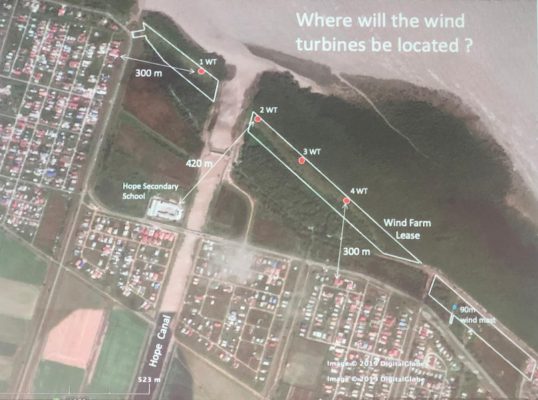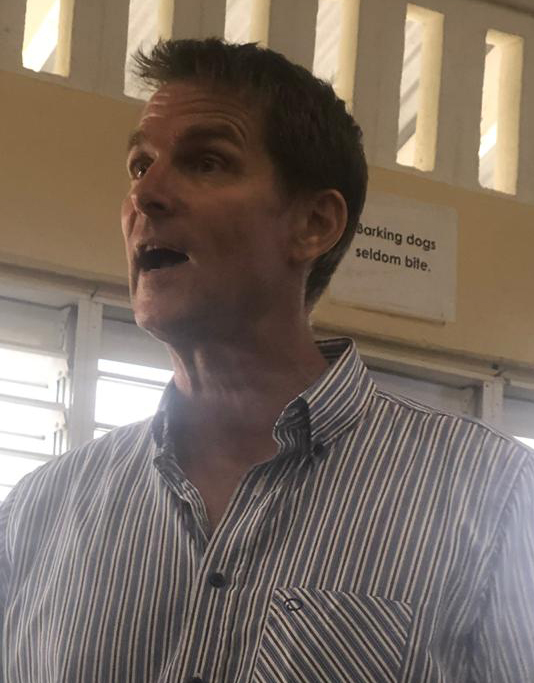When completed at the end of next year, the Hope Wind Farm is expected to save the Guyana Power and Light Inc. (GPL) over US$6.5 million in fuel costs and will produce enough power to supply 7% of the current grid’s demand, according to manager Johan Sydow.
Sydow was addressing a second scoping meeting that was hosted last Tuesday by the Envi-ronmental Protection Agency (EPA) at Hope, East Coast Demerara, where the project will be executed.
The proposed wind farm is expected to annually generate over 50 Gigawatt hours (GWh) of electricity, which will be delivered to GPL’s grid and will lessen Guyana’s reliance on fossil fuels for power generation, reducing the emission of carbon dioxide and other pollutants.

The project will cost an estimated US$30 million and is expected to start sometime next year, with a construction timeframe of six months.
Addressing a number of residents and other stakeholders at the Hope Secondary School, Sydow pointed out that the power generated will not only be enough to supply over 10,000 homes—which is far more than is in the community and surrounding areas—and the four turbines proposed under the project will supply at least 7% of the utility’s current demand for electricity.
Looking towards the future, Sydow said 40 machines of similar stature would be enough to meet at least 100% of the power company’s current demand, and over a year, 60% of all the kW/h that the country consumes at this point in time.
“So you are blessed in Guyana with wind resources that are not that strong, which is a good thing. But it is steady and that is actually what you want. Even at the moment we are currently in the low wind season and it’s still blowing, and not just day time but also in the night. So, in the future when you have your electric cars—and that is not far away—wind electricity will be charging them,” Sydow said, while noting that it is not just about supplying energy to GPL but also helping the country reduce its dependency on fossil fuels.
The project is not expected to hamper the mangroves’ growth in the area, as the turbines will be constructed on a large swath of grass not too far from the shore, and will be constructed at least 1,000 feet from the nearest houses, which he said is following World Bank guidelines on how to position turbines with communities nearby.
They also have to meet stringent noise and safety regulations, and will be ensuring that the nearest home will only experience 45dBa (A-weighted decibels) of sound, which he said is as quiet as an air-conditioning unit.
The project will also be considering the implications of safety distance, shadow flicker, ensuring sensitive birds and bat populations are not at risk, minimising damage and loss of habitat to flora, fauna and farmland, as well as the pollution to waterways during construction.
Sydow said while the early plans were to have about 10 to 15 turbines along the area, the technology has improved over the years so there are larger turbines that make significantly less noise, which makes the project much more viable.
“Even with this pilot project, we are going to sell this energy to GPL at a price that is less than they are paying to run their generators. This is the first step to start transitioning the grid’s renewable energy to scale that is meaningful,” he said.
The project will result in 14.5 million litres of fuel being saved per year and during the construction phase, will provide jobs for 30 to 40 persons. It will also decrease the carbon dioxide emissions by 33,500 tonnes per year.
Sydow said he is also hoping that the project will inspire some of the children in the communities to delve into the field and influence a further change in the future as it relates to transitioning to renewable energy.
In 2015, the government had approved the detailed examination of a proposal by the Guyana Wind Farm Inc. (GWF) for a 26-Megawatt (MW) wind energy plant on the East Coast of Demerara.
However, Lloyd Singh, one of the investors from the GWF, had explained that the project was forced to scale down from its initial 26MW to about 13MW, because of the Hope Canal and Hope Primary School being built around the demarcated area for the project. “The project must be environmentally safe in terms of noise, shadow flickering and we are now working those out to see the size of the turbines and the government how much electricity they will purchase form us,” he had said.
He had also pointed out that the substation at Coldingen was only capable of taking about 10 megawatts, and as a result, power would have to be distributed directly to the Sophia substations, which would be an additional cost.
On signing the Power Purchase Agreement, Singh said that the project will take approximately nine months to complete. “My only concern is that if we want green energy certain agencies like GEA [Guyana Energy Agency] has to come together because everybody wants to do it the right way,” he had noted.
In a letter to Stabroek News in June, 2014, then Prime Minister Sam Hinds, who had responsibility for energy, had said GWF had put forward a very attractive proposal that could see Goldwind of China, rated at least third in the world in the establishment of wind farms, setting up a 10×2.5 MW wind farm at Hope Beach at a total cost of about US$42 million.
Goldwind would provide 75% of total financing and take 51% of the equity shares. Hinds said that he was informed that a financing arrangement was made with Republic Bank for a loan of US$2 million in June of last year.
Hinds did not indicate specifically why a proposed Memorandum of Understanding between GWF and the government had yet to be signed but noted that there were issues that needed to be determined.
“I would like to see an agreement that won’t later create ambiguity to the different sides and so on,” he had said, while hinting that there may be issues with the Power Purchase Agreement that would need to be comprehensively worked out before any agreement was signed.
When Stabroek News had spoken to Singh in 2017, he had related that the Power Purchase Agreement had not yet been negotiated with GPL.









